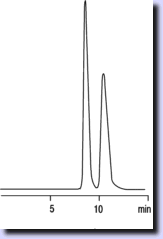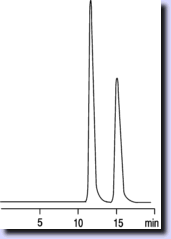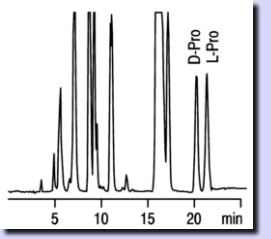| CHIRA-GROM Phases for the separation of chiral molecules by High Performance Liquid Chromatography |
 Experimental details Experimental details
|
|
|
| I. NovoGROM column hardware for chiral
separations |
In order to increase sensitivity, to decrease costs by saving solvents and
for environmental protection tailor-made, customized CHIRA-GROM matrices are packed in the low dispersion NovoGROM microbore columns. This well-designed, excellent column hardware performs
outstandingly in all, even highly sophisticated, chiral separations.
There are three versions of microbore columns packed with CHIRA-GROM-phases available:• Standard microbore column (250 x 2 mm) - connected to the
HPLC-system via 1/16" capillaries, ferrules and compression screws
• Low dispersion microbore
cartridge (250 x 2 mm) - with endfittting adapters and column heads
(quick-connectors)
• Microbore guard column combination (250 x 2 mm column and 10 x 2
mm guard column) - with endfittting adapters, spacer and guard column head
or as a novel alternative:
CHIRA-GROM phases packed in the unique, NovoGROM capillary columns, with fingerthight fittings
Standard capillary column - length 250 mm and 200, 300, 500 or 800 µm i.d.
Capillary column (length 250 mm) with integrated guard column - (lenght 5 or 20 mm) both
columns with 200, 300, 500 or 800 µm i.d. |
|
| II.
Five different CHIRA-GROM matrices are available:
|
CHIRA-GROM Phases Type 1-4 and 9
consist of spherical, highly porous 8 µm silica particles specially treated by a novel thermal process and
covered with layers of synthetic chiral polymers. They are stable up to 35 MPa and may be
used from pH 1 to 8 at temperatures of 0-80°C. With these high-performance materials,
separations of chiral molecules can easily be achieved in the normal phase, as well in the
reversed phase mode. For NovoGROM Method Development Sets for chiral separations follow
link . .There are five major advantages of working in the reversed phase
mode, i.e., using polar solvents to separate chiral molecules: |
| 1) |
After
sample dilution, crude biological samples from conventional matrices can be applied
directly, for instance, by column switching. |
| 2) |
Up
to now, polar chiral molecules insoluble in hydrophobic phases such as heptane etc. could
not be separated.However, now they can be dissolved in polar mobile phases and therefore
are easily separated in the reversed phase mode. |
| 3) |
Gradient
elution is simple in the reversed phase mode. |
| 4) |
For
many separations, better values of "a", i. e., relative retention may be
achieved. |
| 5) |
Column
lifetime is generally superior. |
|
Typical fields of application are:• purity check of chiral samples (pharmaceuticals, agrochemicals,
flavorings)
• chiral drug monitoring of biological materials: plasma, urine,
tissues, etc.
• LC-MS coupling |
|






